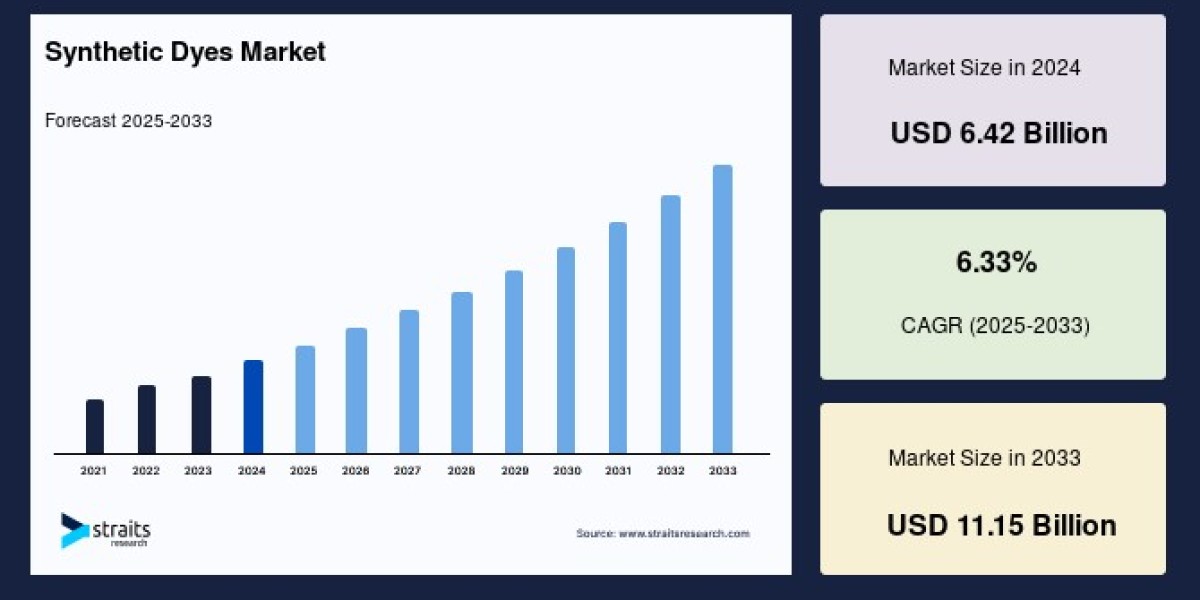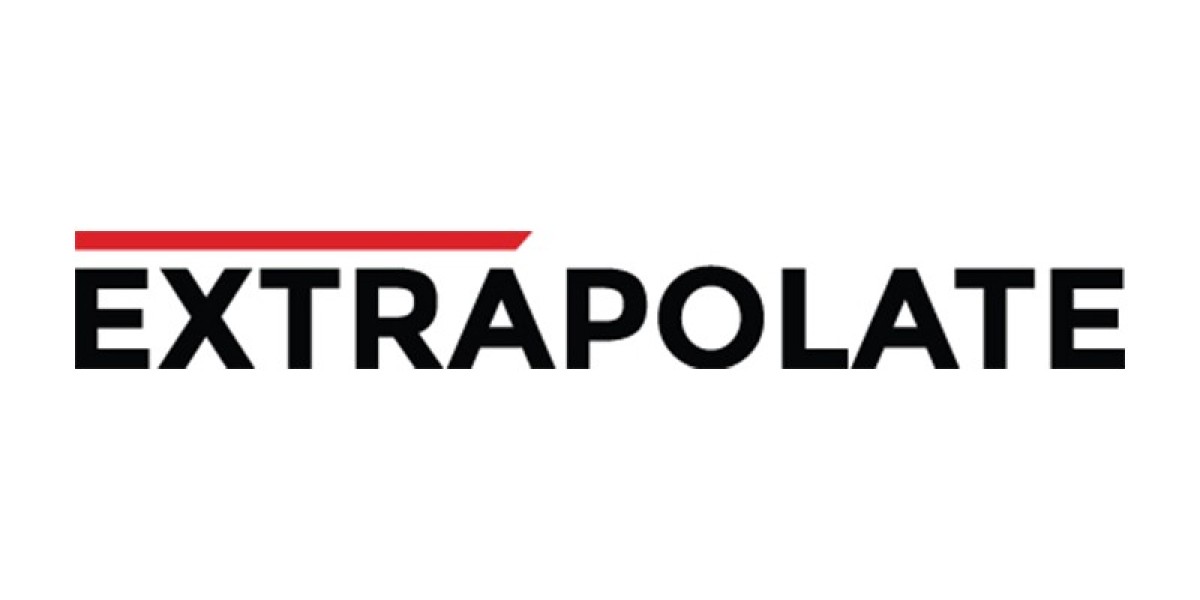Introduction
The global synthetic dyes market plays a vital role in modern manufacturing, particularly in the textile, printing, cosmetics, packaging, and food industries. These dyes are engineered chemicals known for their vibrant colors, high colorfastness, cost-efficiency, and versatility. Unlike natural dyes, synthetic dyes offer consistency, scalability, and a broader color spectrum, making them indispensable in mass production environments.
As consumer preferences evolve, industries are witnessing a shift toward brighter, longer-lasting colors, functional textiles, and sustainable practices. This evolution is transforming the synthetic dyes market, pushing it into a new era of innovation, environmental consciousness, and diversified applications.
Market Overview
The global synthetic dyes market size was valued at USD 6.42 billion in 2024 and is projected to grow from USD 6.82 billion in 2025 to reach USD 11.15 billion by 2033, growing at a CAGR of 6.33% during the forecast period (2025–2033).
The growth trajectory is driven by strong demand from developing economies, advancements in dyeing technology, expanding end-use industries, and the increasing need for performance-enhanced and eco-conscious dye solutions.
Key Market Drivers
1. Rising Demand from the Textile Industry
The textile industry is the largest consumer of synthetic dyes, accounting for a substantial share of the global market. These dyes are essential in coloring fabrics used for clothing, home textiles, sportswear, and industrial applications. As global clothing consumption continues to rise particularly in fast-growing economies so does the need for vibrant and durable dyes.
2. Growth of Technical and Functional Textiles
Industries are increasingly incorporating functionality into textiles, such as UV resistance, flame retardance, anti-bacterial properties, and moisture management. Synthetic dyes are being developed to work with these specialty fabrics, enhancing both performance and aesthetics.
3. Expanding Applications in Non-Textile Sectors
While textiles dominate, synthetic dyes are also in high demand in sectors like packaging, paper printing, cosmetics, food and beverages, pharmaceuticals, and personal care. Branded products rely heavily on consistent color schemes for marketing and recognition, further increasing dye consumption.
4. Cost-Effectiveness and Consistency
Compared to natural dyes, synthetic dyes offer superior consistency, better yield, and lower production costs. These attributes make them particularly valuable in large-scale manufacturing, where uniformity and efficiency are critical.
Market Segmentation
By Dye Type
Acid Dyes: Commonly used for wool, silk, and nylon, offering strong colorfastness.
Basic Dyes: Bright and intense colors, often used in paper and acrylics.
Direct Dyes: Applied directly to fabric without mordants; mainly used for cotton.
Disperse Dyes: Used for synthetic fibers such as polyester.
Reactive Dyes: Chemically bond with fiber molecules, used primarily in cotton textiles.
Vat Dyes: Known for excellent fastness; widely used in denim.
Sulfur Dyes: Economical and used primarily for darker shades in cotton fabrics.
Others: Includes solvent dyes, metal complex dyes, and more.
By Form
Powder
Liquid
Granular
By End-Use Industry
Textile and Apparel
Packaging and Printing
Cosmetics and Personal Care
Paints and Coatings
Food and Beverage
Pharmaceuticals
Others (e.g., leather, plastics)
Regional Insights
1. Asia-Pacific
Asia-Pacific is the dominant market for synthetic dyes, led by countries like China, India, Bangladesh, and Vietnam. These countries house major textile manufacturing hubs and offer low-cost labor, abundant raw materials, and supportive government policies. The region's robust industrial base, combined with rising domestic consumption, continues to fuel demand.
2. North America
The North American market is mature, but innovation and sustainability are pushing the adoption of eco-friendly synthetic dyes. Increasing demand from sectors like food packaging, cosmetics, and technical textiles keeps the market competitive. Stringent regulatory oversight in the U.S. and Canada is driving a shift toward safer dye formulations.
3. Europe
Europe is a strong player in premium and sustainable textile production. Consumers in this region are more inclined toward eco-friendly and certified products. European companies are also investing in biodegradable and non-toxic dye technologies, which are expected to grow in market share over the next decade.
4. Latin America and Middle East & Africa
These regions are emerging markets for synthetic dyes, with growing industrial and textile sectors. As infrastructure and urbanization improve, so does the need for vibrant, durable, and low-cost colorants across a range of applications.
Competitive Landscape
The synthetic dyes market is moderately consolidated with a mix of multinational corporations and regional players. Key competitive strategies include mergers and acquisitions, investment in R&D, expansion into emerging markets, and the development of environmentally friendly products.
Key Players in the Market
BASF SE
Huntsman International LLC
Clariant AG
Archroma
DyStar Group
Kiri Industries Ltd.
Atul Ltd.
Zhejiang Longsheng Group Co., Ltd.
Everlight Chemical Industrial Corporation
Bodal Chemicals Ltd.
These companies are leading innovation in synthetic dye formulations, particularly in the development of low-impact, non-toxic, and high-performance dye systems.
Opportunities and Trends
1. Eco-Friendly and Sustainable Dyes
As environmental awareness increases, synthetic dye manufacturers are under pressure to reduce water usage, eliminate toxic substances, and improve biodegradability. The development of low-salt reactive dyes, bio-based pigments, and waste-derived dye alternatives are gaining traction.
2. Digital Textile Printing
The rise of digital textile printing opens new avenues for synthetic dyes that are compatible with inkjet and thermal transfer technologies. This segment is expected to grow due to its precision, reduced waste, and rapid prototyping capabilities.
3. Regulatory Compliance Driving Innovation
Stringent environmental regulations in Europe and North America are pushing manufacturers to innovate toward safer and compliant dye solutions. Compliance with REACH, GOTS, and other certifications is increasingly becoming a market differentiator.
4. Advanced Textile Applications
The demand for technical textiles in automotive, defense, healthcare, and sports sectors is growing rapidly. These applications require synthetic dyes that can withstand extreme conditions while retaining color integrity.
Challenges in the Market
Environmental Impact: Wastewater from dyeing processes is a major environmental concern, especially in countries with lax wastewater treatment standards.
Health and Safety Risks: Certain synthetic dyes contain harmful compounds that pose health risks to workers and consumers if not handled or processed correctly.
Volatility in Raw Material Prices: Many synthetic dyes are derived from petrochemical sources, making prices sensitive to global oil market fluctuations.
Competition from Natural Dyes: While still niche, natural dyes are gaining market share in premium segments, especially among environmentally conscious consumers.
Future Outlook
The synthetic dyes market is poised for consistent growth over the next decade, supported by global industrial expansion, product innovation, and shifting consumer preferences. The future lies in the ability of manufacturers to deliver high-performance dyes that are cost-effective, safe, and environmentally responsible.
Industries are increasingly leaning toward integrated color management solutions, automated dyeing processes, and digitization all of which favor the development of specialized synthetic dyes. Companies that embrace these trends and focus on sustainability and compliance will be best positioned to lead in the evolving global marketplace.
Conclusion
Synthetic dyes remain an essential element in the modern industrial ecosystem. Their importance spans far beyond aesthetics, influencing functionality, branding, and product lifecycle. As the world becomes more color-driven yet environmentally conscious, the synthetic dyes market stands at a crossroads of tradition and transformation.
With promising opportunities across established and emerging economies, the market’s future is vibrant both in color and potential.







